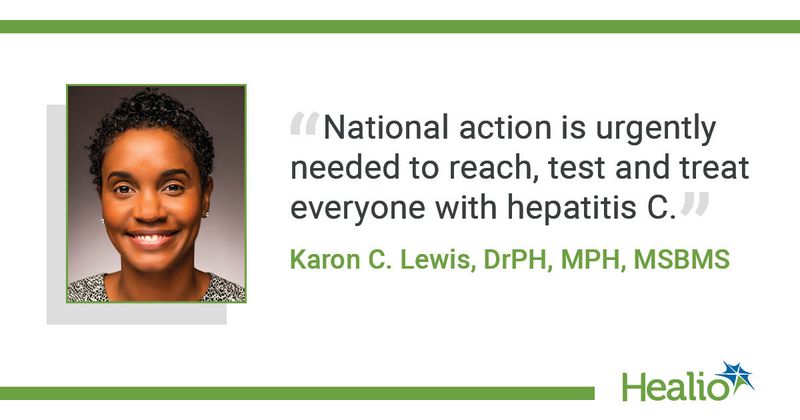Infection
Survey shows only 68% of people with hepatitis C aware of the infection
July 31, 2023
2 min read
Source/Disclosures
Published by:
Disclosures:
The authors report no relevant financial disclosures.
Key takeaways:
- More than 2 million people had current HCV infection, but only 68% were aware of it.
- Infection rates were higher among older adults, people experiencing poverty and those with public or no insurance.
A nationally representative survey revealed that of the more than 2 million people with current hepatitis C virus infection, only 68% are aware of their infection.
“The annual number of new hepatitis C virus (HCV) infections has steadily increased over the past decade,” Karon C. Lewis, DrPH, MPH, MSBMS, Epidemiologist in CDC’s Division of Viral Hepatitis, told Healio.
“This study was conducted to determine the prevalence of HCV infection among people in the United States who are represented in the most current National Health and Nutrition Examination Survey (NHANES), overall and by select characteristics,” Lewis said.
Using NHANES, a multistage, stratified probability survey, Lewis and colleagues collected data from between January 2019 and March 2020 and combined them with data from 2017-2018 to create a nationally representative sample of the U.S. citizens during the 39-month period before the COVID-19 pandemic.
Blood samples from NHANES participants were tested with an HCV antibody screening test, and participants with a reactive screening test then received an HCV RNA test. Estimates of current HCV infection and awareness of HCV infection were calculated among study participants aged 18 years and older, with additional estimates done by sex, age, race and ethnicity, health insurance type and poverty status.
Between January 2017 and March 2020, the estimated prevalence of current HCV infection was 0.9% (95% CI, 0.5%-1.4%), or 2.2 million (95% CI, 1.3-3.6 million), although Lewis said that the actual number of infections is likely higher due to limitations of the NHANES survey, which did not include people who were incarcerated or experiencing homelessness and are thus at an increased risk of HCV exposure.
Approximately 67.7% (95% CI, 50.2%-82.2%) of these participants were aware of their infection — but the researchers noted that this estimate was considered unreliable because the absolute confidence interval width was more than 30% based on published National Center for Health Statistics standards.
When assessed by age, people aged 55 to 64 years were 6.4 times as likely to have current HCV infection compared with those aged 18 to 40 years (prevalence ratio [PR] = 6.4; 95% CI, 2.5-16.4) and that men were 2.9 times as likely as women to have current HCV infection (PR = 2.9; 95% CI, 1.1-7.7).
When assessed by race and ethnicity, the study showed that non-Hispanic white and non-Hispanic Black people were 5 times (PR = 5; 95% CI, 1.6-15.7) and 4.9 times (PR = 4.9; 95% CI, 1.7-14) as likely to have current HCV infection compared with participants of other races and ethnicities.
Additionally, the study revealed that prevalence of HCV infection was 5.3 times as high among people experiencing poverty compared with those not experiencing poverty (PR = 5.3; 95% CI, 2.3-12.2).
Similar results were seen among people with public insurance and persons with no insurance who were 4.7 times (PR = 4.7; 95% CI, 1.6-14.3) and 5.8 times (PR = 5.8; 95% CI, 1.7-19.8) as likely to have current HCV infection compared with people with private insurance.
“Safe and highly effective medicines to cure hepatitis C have been available since 2014, but this estimate reiterates that millions of people still have not been cured — and we estimate there are more than 60,000 new infections every year. National action is urgently needed to reach, test, and treat everyone with hepatitis C,” Lewis said.
“We need to work toward making testing and treatment available in all settings where people with hepatitis C receive care,” Lewis said. “All people with hepatitis C should know their status and benefit from treatment.”

